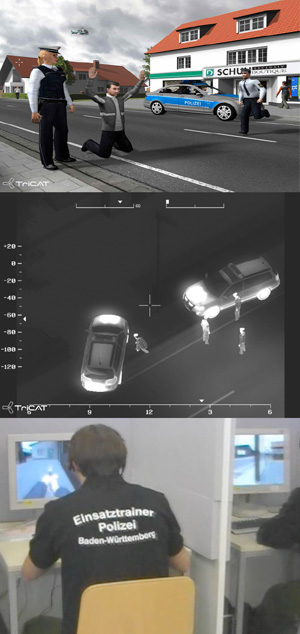3D Virtual World Superior to Traditional Training for Police Officers
![]() In a recent study appearing in Cyberpsychology, Behavior, and Social Networking, Moskaliuk, Bertram and Cress1 examined the value of virtual training environments for training effective coordination between ground police officers and a helicopter crew. This study thus applied virtual environments to one of the situations that I have previously argued is ideal for the application of virtual worlds: a training context where the outcome is highly complex and real-world training would be expensive and dangerous. In this case, in-person training would require helicopters! What better reason do you need to use a virtual world?
In a recent study appearing in Cyberpsychology, Behavior, and Social Networking, Moskaliuk, Bertram and Cress1 examined the value of virtual training environments for training effective coordination between ground police officers and a helicopter crew. This study thus applied virtual environments to one of the situations that I have previously argued is ideal for the application of virtual worlds: a training context where the outcome is highly complex and real-world training would be expensive and dangerous. In this case, in-person training would require helicopters! What better reason do you need to use a virtual world?
So did it work? Here’s the short version: the virtual world-based training was as effective as traditional (lecturer plus simulation) training in teaching the officers facts and information about the exercise. But more critically, officers completing the virtual training were better able to later apply what they learned to real situations. Thus, virtual environments were more effective than a traditional in-person simulation at teaching officers needed real-world skills. As suggested by Gardner’s most recent depiction of the hype cycle, it seems we are finally entering the Slope of Enlightenment for virtual worlds.
 To test their hypotheses, the researchers assigned 47 German federal police officers to 8-person teams, which were in turn assigned to one of three conditions. Trainees all received in-person training on strategies and rules for the exercise followed by the treatment of their particular condition:
To test their hypotheses, the researchers assigned 47 German federal police officers to 8-person teams, which were in turn assigned to one of three conditions. Trainees all received in-person training on strategies and rules for the exercise followed by the treatment of their particular condition:
- Traditional training. Officers completed in-person training with a trainer, in which communication with the helicopter was simulated.
- Virtual training. Officers completed the VTE Police Force simulation while wearing headsets to communicate with each other (see images to the right).
- Control condition. Officers completed a distraction task (completed a group activity based on an unrelated handout).
In the spirit of the Kirkpatrick model, reactions, knowledge, and transfer were next measured. Reactions and learning were measured with surveys, while transfer was measured by evaluating written responses by officers to 11 video vignettes. Reaction outcomes were lower for traditional training; trainees did not feel like virtual training was as realistic or as applicable to real life in comparison to virtual training. Despite this, knowledge outcomes were similar between training conditions. 22% of the variance in transfer performance was explained by variance in conditions, with transfer from virtual training significantly higher than the traditional training and the control.
Overall, this provides compelling evidence that virtual worlds are a viable – and perhaps even preferable – setting for complex training tasks. The only negative outcome was the motivational component – although trainees had similar knowledge and superior transfer from virtual training, they felt like the traditional training was superior. But as Rachel Callan and I recently suggested, training targeted at increasing virtual world acceptance by trainees may be the solution to this one remaining barrier.
Note. Images in this blog post were taken from another paper by the authors2.
- Moskaliuk, J., Bertram, J., & Cress, U. (2013). Impact of Virtual Training Environments on the Acquisition and Transfer of Knowledge Cyberpsychology, Behavior, and Social Networking DOI: 10.1089/cyber.2012.0416 [↩]
- Moskaliuk, J., Bertram, J., & Cress, U. (2011). Training in virtual training environments: Connecting theory to practice. Connecting Computer-Supported Collaborative Learning to Policy and Practice: CSCL2011 Conference Proceeding, Vol 1., 192-199 [↩]
| Previous Post: | If You Believe in MOOCs, You Are Assuming Too Much |
| Next Post: | Trust, Shared Values, Reputation of Online Reviewers Influence Purchase Decisions |